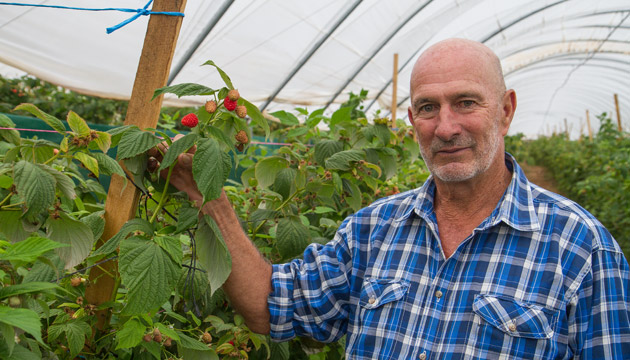Whether taking on leadership roles within farming or over at the local footy club, energetic Tasmanian Mike Badcock is an inspiring example of how one man can make a difference.
Story and Photos Andrew Bain
From the kitchen of Mike Badcock’s farmhouse at Forth, in northern Tasmania, there are two contrasting views that seem to reflect the diverse nature of his life. In one direction, carrots stripe the glorious red soil of his 140-hectare farm. In the other is the entrance to his office, where almost the entire floor is covered in metre-high stacks of paper.
“I’ve always been a copious note taker,” Mike says. “I’ve got diaries for the last 40 years. Every meeting I’ve ever attended is in those diaries. I could write a good book ... or probably books.” It would make compelling reading – the story of this Tasmanian vegetable farmer so committed to farming issues and community life that he was named the inaugural Rural Community Leader of the Year at the Australian Farmer of the Year Awards late last year.
It was recognition of almost half a century as a leading figure in farming organisations and his local community. In the awards submission, alone, the list of board and association positions and community posts he’s held stretched for more than four pages.
“I really admire his energy – I don’t know where he gets it from,” says Ian Young, a former director at the national growers’ association AUSVEG, who’s known Mike for about 35 years. “He’s absolutely passionate about the industry, both locally and nationally. A bronze statue should be made of him.”
Mike is a sixth-generation Tasmanian farmer, with the first Badcock ancestor arriving in the Longford region from Cornwall in 1831. “He proceeded to have 11 children with his first wife, who then died,” Mike says. “Then he married the housekeeper and had another 12 children, so I come from quite a line of Badcocks.”
It was Mike’s parents, Lloyd and Barbara, who moved to the Forth area, near Devonport, in 1947 – the year before Mike, the eldest of six children, was born. It was a time when the area was predominantly dairy and sheep, with no irrigation. Lloyd and Barbara bought a run-down 60ha farm, of which only about 2.5ha was cleared, the rest comprised of bush and blackberries. With just two horses and a horse-drawn mower, Lloyd cleared the land and, together with Mike, helped pioneer irrigation and the vegetable industry that now dominates this fertile part of Tasmania.
Mike’s childhood neighbour and lifelong friend Philip Jarman says it’s Lloyd’s work ethic that now shines through in Mike. “If anybody needed a hand, his father would be the first there, and Mike’s very much the same,” Philip says. “Lloyd was very well respected in the area. If he had something to say, people listened, and it’s the same with Mike. He’s very much a chip off the old block.”
Mike began working on the family farm immediately out of school. By the age of 21 he’d taken his first step into representational life, taking on the role of secretary of the north-west branch of the now-defunct Tasmanian Farmers Federation. “I think it started because my parents were very involved in local communities and farming organisations, and I can remember going along with my father to these meetings, and I suppose I couldn’t shut up,” he says. “I’d make certain comments, and next thing you know, you get jobs. And it evolved from that.”
Among numerous other posts, Mike would go on to spend five years as chairman of the Tasmanian Farmers and Graziers Association Vegetable Council. He’s been a member of the Poppy Growers Tasmania executive committee for the past 30 years, sits on Tasmania’s State Water Strategy Committee, was a long-time state delegate to the Australian Vegetable Growers Association, and spent five years as chairman of AUSVEG. It represents thousands of hours of service and work. Add in the running of his own vegetable farm and it’s clear that Mike is a person of extraordinary drive and energy.
“I wish I knew where I got it from,” he laughs.
This story excerpt is from Issue #113
Outback Magazine: June/July 2017










